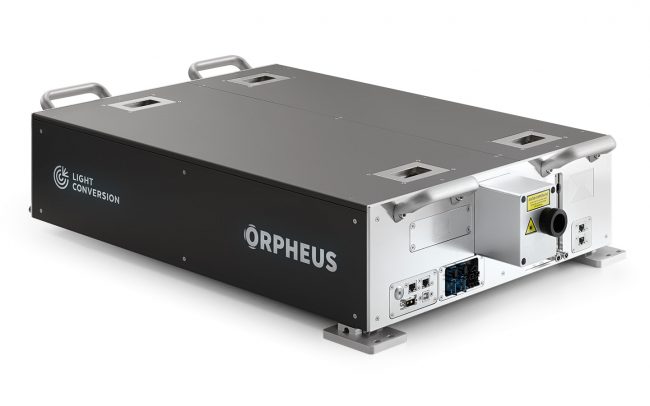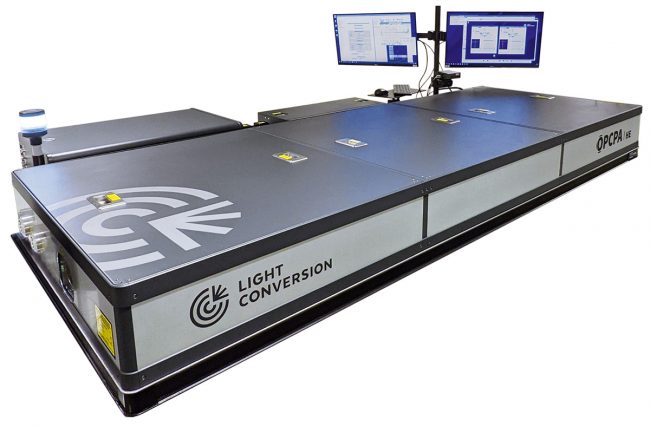Awarded by the Nobel Prize in 2018, a chirped pulse amplification (CPA) technology for high-energy lasers has revolutionized the whole ultrashort laser science. The CPA technique is intended for boosting the power of ultrashort pulses while avoiding optical damage to the lasing medium. Nowadays, it is widely used by modern ultrashort pulse laser amplifier systems, whether they are compact laser systems, such as PHAROS and CARBIDE lasers, or large petawatt peak power laser systems. However, multiple scientific applications require high-intensity pulses at different spectral ranges, and the solution was found by introducing the optical parametric chirped-pulse amplification (OPCPA).
The first proof-of-concept experiment on stretching, amplification, and compression of chirped pulses in an optical parametric amplifier (OPA) was demonstrated in 1992 by a Vilnius University research group led by prof. A. Piskarskas. It was proposed that using high-energy pump pulses to amplify chirped and stretched signal in OPA will allow boosting the power of femtosecond pulses up to a terawatt level. Since then, the OPCPA has become a widely recognized and rapidly developing amplification technology for high-power femtosecond pulse generation and even more powerful systems have been demonstrated, reaching petawatt peak powers. More so, the OPCPA technology has been used to generate not only ultrahigh power pulses but also extremely short (few-cycle) pulses and such few-cycle pulses have been experimentally obtained in the visible (VIS), near-infrared (NIR), and mid-infrared (MIR) spectral ranges. Currently, the OPCPA is the only laser technology simultaneously providing high peak and average power, as well as a few-cycle pulse duration required by the most demanding scientific applications.
LIGHT CONVERSION’s answer to these demands is a portfolio of cutting-edge OPCPA systems based on years of experience developing and manufacturing OPAs and femtosecond lasers. Due to inherently high-contrast output pulses, OPCPAs have also been adopted as front-ends in a number of ultra-high intensity lasers because of certain advantages over other temporal contrast enhancement techniques. Pulses with relatively high contrast after optical parametric amplifiers are then further amplified in laser amplifiers up to ultra-high energies. The state-of-the-art OPCPA systems are built using our front-ends. Benefiting from the industrial-grade stability and reliability of PHAROS and CARBIDE lasers, ORPHEUS-OPCPA delivers few-cycle, CEP-stable pulses in a package as compact as our standard parametric amplifiers. Furthermore, ORPHEUS-OPCPA may serve as a seed source for larger amplifiers, delivering background-free pulses with near-single-cycle bandwidths, excellent spectral phase coherence, and CEP stability.
Another OPCPA highlight is the SYLOS single-cycle laser at ELI-ALPS (Extreme Light Infrastructure Attosecond Light Pulse Source), built by LIGHT CONVERSION and EKSPLA consortium. The SYLOS laser system is based on LIGHT CONVERSION’s OPCPAs driven by our PHAROS femtosecond laser and EKSPLA’s picosecond laser. The basic working principle of the system can be described as follows. The PHAROS laser pumps two femtosecond OPAs. The first OPA produces a passively CEP-stabilized pulse at 1.3 µm for the generation of a CEP-stable white-light continuum. At the same time, the second OPA amplifies the white-light continuum in the 700 – 1000 nm spectral range, providing a high-contrast seed pulse for the subsequent OPCPA stages. The pulse, amplified to 50 mJ pulse energy and centered at 850 nm wavelength, is compressed in a sequence of glass blocks and chirped mirrors down to 10 fs pulse duration. Read more on the SYLOS laser system in a recent article by S. Toth et al. For such and similar high-energy OPCPA systems, refer to OPCPA-HE. If high repetition rate is desired, refer to ORPHEUS-OPCPA, and do not hesitate to contact us for custom specifications.
- 少周期脉冲,结构紧凑,占地面积小
- 800 nm、1600 nm、2000 nm 或 3000 nm 输出
- 高达MHz的重复频率
- 高对比度种子源,适用于 CPA 和 OPCPA 系统
- 卓越的功率、脉冲能量和 CEP 稳定性
- SH/TH 可选
- 高达 1 kHz 的 TW 级峰值功率脉冲
- 800 nm、1600 nm 或 2000 nm 输出
- 少周期的脉宽和高前脉冲对比度
- 设计坚固,预热时间<1小时
- 卓越的 CEP 和脉冲能量稳定性
Spatio-spectral couplings in optical parametric amplifiers
A. D. Andres, S. W. Jolly, P. Fischer, A. A. Muschet, F. Schnur, and L. Veisz, Optics Express 8 (31), 12036 (2023).
Utilizing the temporal superresolution approach in an optical parametric synthesizer to generate multi-TW sub-4-fs light pulses
A. A. Muschet, A. D. Andres, P. Fischer, R. Salh, and L. Veisz, Optics Express 3 (30), 4374 (2022).
SYLOS lasers – the frontier of few-cycle, multi-TW, kHz lasers for ultrafast applications at extreme light infrastructure attosecond light pulse source
S. Toth, T. Stanislauskas, I. Balciunas, R. Budriunas, J. Adamonis, R. Danilevicius, K. Viskontas, D. Lengvinas, G. Veitas, D. Gadonas et al., Journal of Physics: Photonics 4 (2), 045003 (2020).
Thin-disk laser-pumped OPCPA system delivering 44 TW few-cycle pulses
M. Kretschmar, J. Tuemmler, B. Schütte, A. Hoffmann, B. Senfftleben, M. Mero, M. Sauppe, D. Rupp, M. J. J. Vrakking, I. Will et al., Optics Express 23 (28), 34574 (2020).
53 W average power CEP-stabilized OPCPA system delivering 55 TW few cycle pulses at 1 kHz repetition rate
R. Budriūnas, T. Stanislauskas, J. Adamonis, A. Aleknavičius, G. Veitas, D. Gadonas, S. Balickas, A. Michailovas, and A. Varanavičius, Optics Express 5 (25), 5797 (2017).
Performance tests of the 5 TW, 1 kHz, passively CEP-stabilized ELI-ALPS SYLOS few-cycle laser system (Conference Presentation)
T. Stanislauskas, R. Budriunas, G. Veitas, D. Gadonas, J. Adamonis, A. Aleknavičius, G. Masian, Z. Kuprionis, D. Hoff, G. G. Paulus et al., in High-Power, High-Energy, and High-Intensity Laser Technology III, J. Hein, ed. (SPIE, 2017).
The ELI-ALPS facility: the next generation of attosecond sources
S. Kühn, M. Dumergue, S. Kahaly, S. Mondal, M. Füle, T. Csizmadia, B. Farkas, B. Major, Z. Várallyay, E. Cormier et al., Journal of Physics B: Atomic, Molecular and Optical Physics 13 (50), 132002 (2017).
Passively CEP-stabilized frontend for few cycle terawatt OPCPA system
R. Budriūnas, T. Stanislauskas, and A. Varanavičius, Journal of Optics 9 (17), 094008 (2015).
Table top TW-class OPCPA system driven by tandem femtosecond Yb:KGW and picosecond Nd:YAG lasers
T. Stanislauskas, R. Budriūnas, R. Antipenkov, A. Zaukevičius, J. Adamonis, A. Michailovas, L. Giniūnas, R. Danielius, A. Piskarskas, and A. Varanavičius, Optics Express 2 (22), 1865 (2014).
10-mJ optically synchronized CEP-stable chirped parametric amplifier at 1.5 µm
O. D. Mücke, D. Sidorov, P. Dombi, A. Pugžlys, S. Ališauskas, V. Smilgevičius, N. Forget, J. Posius, L. Giniūnas, R. Danielius et al., Optics and Spectroscopy 3 (108), 456-462 (2010).


